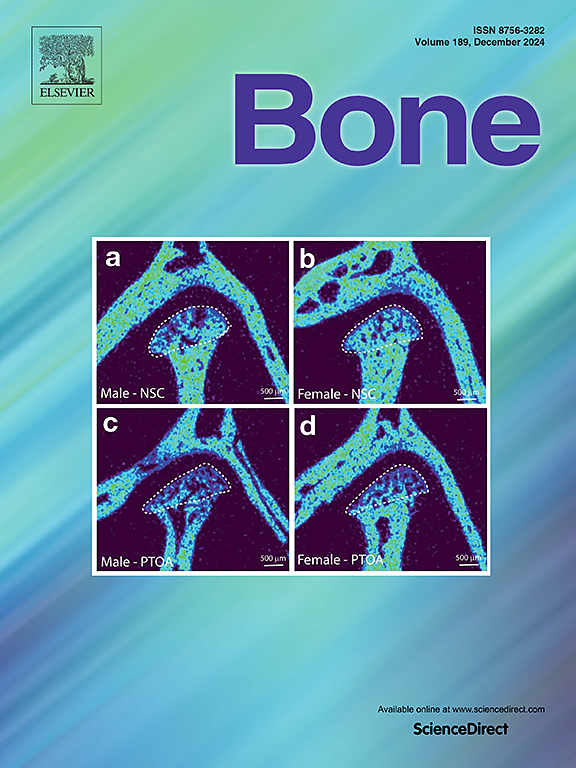预防和治疗杜兴氏肌肉萎缩症患者骨质疏松症的药物和非药物疗法:系统综述。
IF 3.5
2区 医学
Q2 ENDOCRINOLOGY & METABOLISM
引用次数: 0
摘要
背景:长期糖皮质激素治疗杜氏肌营养不良症(DMD)与脆性骨折的高发相关。本系统综述旨在评估目前DMD儿童和成人骨质疏松症的药物和非药物治疗证据。方法:检索三个在线数据库(Embase, Medline, Cochrane Library),以评估干预治疗或预防DMD骨质疏松症的研究。纳入的研究必须报告骨密度(BMD)或骨矿物质含量(BMC) z评分或骨折发生率的变化。结果:19项研究被确定,包括12项评估双膦酸盐,3项评估睾酮(2项研究同一患者组),1项评估维生素D/钙,1项评估特立帕肽,2项评估振动疗法。只有两项随机对照试验被发现,一项是静脉注射双膦酸盐,另一项是振动疗法。在研究中,双膦酸盐组腰椎骨密度的变化范围为-0.3至+1.3,振动治疗组为- 0.2至0.0,而睾酮组为+0.38,维生素D/钙组为+ 0.9。所有研究中关于骨折影响的信息有限。没有一项药理学研究涉及骨折naïve基线组。此外,没有一项研究针对18岁以上的人群。结论:本系统综述为双膦酸盐治疗改善儿童和青少年DMD骨密度的有效性提供了证据。然而,关于其对骨折的影响的信息较少。该综述没有发现专门针对18岁以上DMD患者的研究,也没有发现关于非双膦酸盐药物的有限信息。本文章由计算机程序翻译,如有差异,请以英文原文为准。
Pharmacological and non-pharmacological therapies for prevention and treatment of osteoporosis in Duchenne Muscular Dystrophy: A systematic review
Background
Long term glucocorticoid treatment in Duchenne Muscular Dystrophy (DMD) is associated with a high incidence of fragility fractures. This systematic review aims to assess the current evidence for pharmacological and non-pharmacological treatment for osteoporosis in children and adults with DMD.
Methods
Three online databases (Embase, Medline, Cochrane Library) were searched for studies that evaluated interventions for treatment or prevention of osteoporosis in DMD. Included studies had to report changes in bone mineral density (BMD) or bone mineral content (BMC) Z-scores or fracture incidence.
Results
Nineteen studies were identified, including twelve that evaluated bisphosphonate, three evaluated testosterone (2 studies of the same patient group), one evaluated vitamin D/calcium, one teriparatide, and two evaluated vibration therapy. Only two randomised-controlled trials were found, one of intravenous bisphosphonate and one of vibration therapy. Changes in lumbar spine BMD ranged from −0.3 to +1.3 in studies of bisphosphonate and − 0.2 to 0.0 with vibration therapy, whereas this was +0.38 with testosterone and + 0.9 with vitamin D/calcium. There was limited information on impact on fracture in all studies. None of the pharmacological studies involved a fracture naïve group at baseline. In addition, none addressed a group of individuals over 18 years at baseline.
Conclusion
This systematic review provides evidence for the effectiveness of bisphosphonate therapy in improving bone density in children and adolescents with DMD. However, there is less information on the impact on fracture. The review did not find studies exclusively in those over 18 years old with DMD and limited information on non-bisphosphonate pharmacological agents.
求助全文
通过发布文献求助,成功后即可免费获取论文全文。
去求助
来源期刊

Bone
医学-内分泌学与代谢
CiteScore
8.90
自引率
4.90%
发文量
264
审稿时长
30 days
期刊介绍:
BONE is an interdisciplinary forum for the rapid publication of original articles and reviews on basic, translational, and clinical aspects of bone and mineral metabolism. The Journal also encourages submissions related to interactions of bone with other organ systems, including cartilage, endocrine, muscle, fat, neural, vascular, gastrointestinal, hematopoietic, and immune systems. Particular attention is placed on the application of experimental studies to clinical practice.
 求助内容:
求助内容: 应助结果提醒方式:
应助结果提醒方式:


